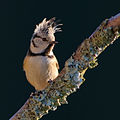The crested tit or European crested tit (Lophophanes cristatus) (formerly Parus cristatus), is a passerine bird in the tit family Paridae. It is a widespread and common resident breeder in coniferous forests throughout central and northern Europe and in deciduous woodland in France and the Iberian Peninsula. In Great Britain, it is chiefly restricted to the ancient pinewoods of Inverness and Strathspey in Scotland, and seldom strays far from its haunts. A few vagrant crested tits have been seen in England. It is resident, and most individuals do not migrate.
Taxonomy
The crested tit was formally described in 1758 by the Swedish naturalist Carl Linnaeus in the tenth edition of his Systema Naturae under the binomial name Parus cristatus.[2] Linnaeus specified the type locality as Europe but this was restricted to Sweden by German naturalist Johann Jakob Kaup in 1905.[3][4] The crested tit is now placed together with grey-crested tit in the genus Lophophanes that was introduced in 1829 by the German naturalist Johann Jakob Kaup.[5] The current genus name, Lophophanes, is from the Ancient Greek lophos, "crest", and phaino, "to show". The specific cristatus is Latin for "crested".[6]
This species was formerly placed in Parus, but the distinctness of Lophophanes is well supported,[7] and it is now recognised by the American Ornithologists' Union and the British Ornithologists' Union as a distinct genus.[8]
Seven subspecies are recognised:[5]
- L. c. scoticus Pražák, 1897 – central north Scotland
- L. c. abadiei (Jouard, 1929) – west France
- L. c. weigoldi (Tratz, 1914) – west, south Iberian Peninsula
- L. c. cristatus (Linnaeus, 1758) – north, east Europe to the Carpathian Mts.
- L. c. baschkirikus Snigirewski, 1931 – southwest, central Ural Mountains
- L. c. mitratus (Brehm, CL, 1831) – central Europe to northeast Spain, the Alps and north Balkans
- L. c. bureschi (von Jordans, 1940) – Albania to Bulgaria and Greece
Behaviour and ecology
It is an easy tit to recognise, for besides its erectile crest, the tip of which is often recurved, its gorget and collar are distinctive. It is, like other tits, talkative, and birds keep up a constant zee, zee, zee ⓘ, similar to that of the coal tit.
It makes a nest in a hole in rotting stumps. This bird often feeds low down in trees, but although not shy, it is not always easily approached. It will join winter tit flocks with other species.
Like other tits it is found in pairs and it feeds on insects (including caterpillars) and seeds.
Gallery
-
Crested tit, Aviemore, Scotland
-
Crested tit, Aviemore, Scotland
-
Crested tit, Cantalejo, Spain
-
Eggs, Collection Museum Wiesbaden
-
Lophophanes cristatus - MHNT
References
- ^ BirdLife International (2016). "Lophophanes cristatus". IUCN Red List of Threatened Species. 2016: e.T22711810A87427182. doi:10.2305/IUCN.UK.2016-3.RLTS.T22711810A87427182.en. Retrieved 19 November 2021.
- ^ Linnaeus, Carl (1758). Systema Naturae per regna tria naturae, secundum classes, ordines, genera, species, cum characteribus, differentiis, synonymis, locis (in Latin). Vol. 1 (10th ed.). Holmiae (Stockholm): Laurentii Salvii. p. 189.
- ^ Kaup, Johann Jakob (1829). Skizzirte Entwickelungs-Geschichte und natürliches System der europäischen Thierwelt (in German). Darmstadt: Carl Wilhelm Leske. p. 92.
- ^ Paynter, Raymond A. Jr, ed. (1986). Check-list of Birds of the World. Vol. 12. Cambridge, Massachusetts: Museum of Comparative Zoology. p. 96.
- ^ a b Gill, Frank; Donsker, David; Rasmussen, Pamela, eds. (August 2024). "Waxwings and their allies, tits & penduline tits". IOC World Bird List Version 14.2. International Ornithologists' Union. Retrieved 23 February 2025.
- ^ Jobling, James A (2010). The Helm Dictionary of Scientific Bird Names. London: Christopher Helm. pp. 122, 230. ISBN 978-1-4081-2501-4.
- ^ Gill, F.B.; Slikas, B.; Sheldon, F.H. (2005). "Phylogeny of titmice (Paridae): II. Species relationships based on sequences of the mitochondrial cytochrome-b gene". The Auk. 122 (1): 121–143. doi:10.1093/auk/122.1.121.
- ^ Sangster, George; Collinson, J Martin; Helbig, Andreas J; Knox, Alan G; Parkin, David T (2005). "Taxonomic recommendations for British birds: third report". Ibis. 147 (4): 821–826. doi:10.1111/j.1474-919X.2005.00483.x.[dead link]
External links
- Crested tit videos, photos & sounds on the Internet Bird Collection
- Song of the crested tit[permanent dead link] (Real Audio soundfile from Sveriges Radio P2)
- Ageing and sexing (PDF; 2.3 MB) by Javier Blasco-Zumeta & Gerd-Michael Heinze














